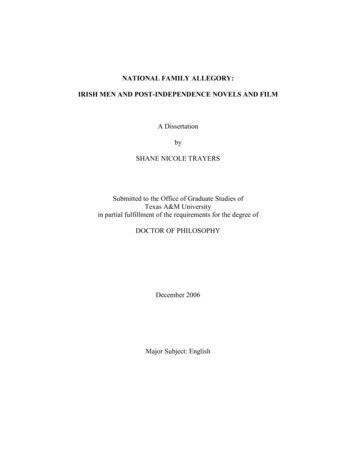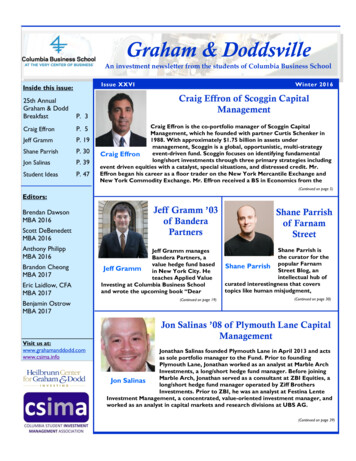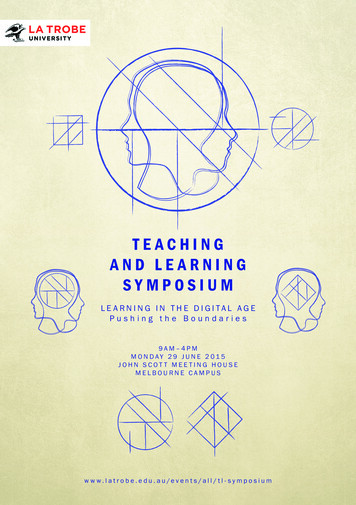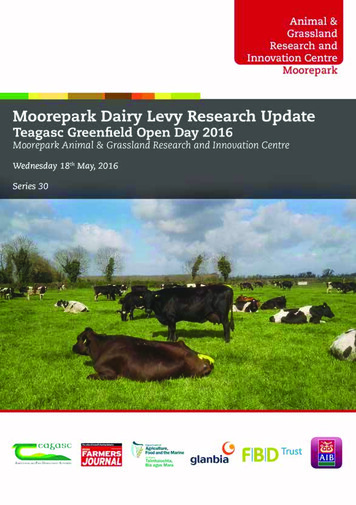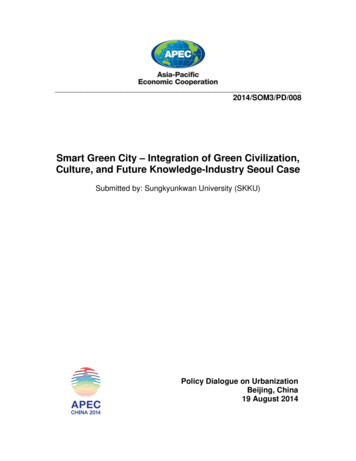
Transcription
Shane A. Green
One major criticism of ESDs is that they are not basedon (enough) data More data better credibility Expertise should be applied to data interpretation (no blackboxes, no “data-less” theories) Some data is more valuable than other data no data is useless
What data was collected? What metrics were recorded (production, cover, density,frequency) Which concepts were used? (annual production vs. peakstanding crop, foliar vs. canopy cover) What techniques were used (double sampling vs. comparativeyield vs. ocular estimates, point vs. linear vs. plot covertechniques) Where was the data recorded? Ecological Site identificationSoil IdentificationGeographic Location (coordinates, T, R & Section)Random or deliberate site selection
Why was the data collected? Monitoring vs. assessment Wildlife / watershed / livestock purpose and focus Ground truth for remote sensing When was the data collected? Concepts and techniques change over time i.e. density cover in old terminology Temporal context i.e. Pre or post-settlement, pre or post-invasive plants,management history
Who collected the data? Agency or individual reputation or bias
Plant Communities Section Annual production and cover byspecies State and transition models Plant community structure
Range Sites – they were based on some data Old dusty files need to be examined and organized Historical data Journals and accounts, survey notes Partner agencies Division of Wildlife, BIA, BLM, USFS, Universities NRCS sources Field offices, NRI
Some Plant-Soil Relationships on an Ungrazed Range Area of Southeastern IdahoH. B. Passey and V. K. Hugie, Journal of Range Management,Vol. 16, No. 3 (May, 1963), pp. 113-118
“The inventory location has burned within the last few years, removing most of the nativeshrub species and releasing the Bluebunch wheatgrass. Broom snakeweed has increased inspots as expected following a wildfire.”19602010
H-P UT1-60SpeciesH-PTwoH-P two- H-P two- yearyearyear Ecologaverage average icalSymbol lbs/ac % comp StatusGrassesBluebunch wheatgrassPSSP6Nevada bluegrassPONESandberg bluegrassPOSECheatgrassBRTEBottlebrush squirreltailELEL5Soft bromeBRHO2Thickspike wheatgrass ELLA3Basin wildryeLECI4Needle-and-threadHECO26Indian ricegrassACHYBulbous bluegrassPOBUForbsYellow sweetcloverWavyleaf thistleArrowleaf balsomrootYellow salsifyLongleaf phloxCussion phloxBrowse milkvetchNW Indian paintbrushAmerican vetchFoothill deathcamasTall tumblemustardSpurred lupineNavajo fleabaneLongleaf hawksbeardAlfalfaOther forbsOther annualsShrubsMountain big sagebrushBitterbrushGreen rabbitbrushBroom snakeweedSmooth horsebrushRubber rabbitbrushUtah juniperOther woodyTotals:H-PTwo2009200920092009yearInventory Inventory Inventory InventoryForageinin %Ecological 0020100000000007521005821499910052456
Campbell: “Pass down thro a bottom of beautiful wheat grass 4&5 inches abovethe snow” Haight: “Came over a sage plain 5 miles to (Cove) Creek
Campbell: “Pass down thro a bottom of beautifulwheat grass 4&5 inches above the snow” Haight: “Came over a sage plain 5 miles to (Cove)CreekUpland loam (Mountain big sagebrush)
http://www.glorecords.blm.gov/
U of U Ph. D. in GeographyUsed old photography taken by H.LShantz, from the U of A Herbariumarchives. 1908-1925. Botanical noteswere found with each photograph.
1912 Green molly dominance1978 Bur buttercup, Cheatgrass, Sanddropseed, Western Wheatgrass,Sagebrush
From: Starkey, Paul [mailto:Paul.Starkey@bia.gov]Sent: Wednesday, January 18, 2012 1:58 PMTo: Green, Shane - NRCS, Salt Lake City, UTSubject: Range inventory data from U&O Reservation. Hi Shane,I spoke with you at the Soil Survey Planning Meeting there, back in November. I am the one doing the rangelandinventory on the Uintah & Ouray Reservation. Sorry it took so long to get back to you. I figured I would just wait untilafter the holidays and other chaos before I reconnected with folks regarding the soil survey and range inventory. Thisalso gave me a chance to go through some of the field data more and get things better organized. I am still in theprocess of working in GIS creating tables with slopes etc and calculating actual usable acreages.You mentioned you would be interested in our field data to help with ecological site descriptions, and I would beinterested in getting your input on some of our methods and the best ways to make sense of all this data. I don’t knowwhat your schedule is like, or what ideas you may have on exchanging information, but I was thinking if you are ever inthis part of Utah perhaps we could set up a meeting and I could show you what is going on from our end. At that pointmaybe we could set up a plan for working together going forward. Let me know what your thoughts are and whatwould work best for you. With budgets being the way they are travel is becoming more difficult, but otherwise I amfairly flexible. Paul StarkeyRangeland Management SpecialistBureau of Indian AffairsUintah & Ouray Agency
NRCS sources Old 417sConservation PlansSoil/Vegetation relationships teamNRI BLM sources SVIM Data Ecological Site Inventory Data Monitoring Data University sources GAP analysis (ground truth photos and data)
USFS sources TEUI data Monitoring data BIA sources Range inventory data State Agency sources DWR Big Game Range Trend Historical sources Journals Survey notes Photography
Go to your meetings and make the contacts with partnersBe aware – browse the lit. cited of interesting papersand follow up on themGoogleBLM survey notes web pageBe a snoop – open the dusty boxes
Data is expensive and hard to acquire, therefore allsources of existing data should be exploited before wecreate new data. Even though a data source may not have beencollected in a way that would be most useful to us(‘correct’ techniques and procedures), it still has value. Data can inform the mere presence or absence of aspecies, species dominance, expected amounts (coverand production), and plant community possibilities inthe S&TM
From: Starkey, Paul [mailto:Paul.Starkey@bia.gov] Sent: Wednesday, January 18, 2012 1:58 PM To: Green, Shane - NRCS, Salt Lake City, UT Subject: Range inventory data from U&O Reservation. Hi Shane, I spoke with you at the Soil Survey Planning Meeting there, back in November. I am the one doing the rangeland inventory on the Uintah & Ouray Reservation.


